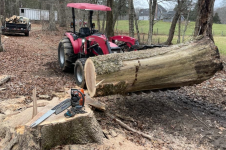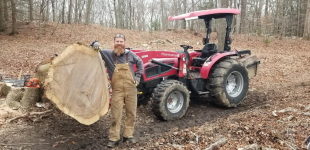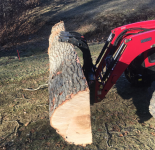That's not what breakout means. Breakout is the force at the pin at ground level, when using the loader lift cylinders. That force generally decreases as height increases, due to geometry. It's why manufacturers often give both. Breakout matters when you're trying to lift out of a pile, or pick up a pallet or something at ground level.
I’m not sure how to explain this to you. Break out force and lift use different hydraulics, different angles, different ways. For breakout if you laid the bucked flat on the ground and put the breakout number at the far edge of the bucket you could curl the bucket and it would lift the weight but the back/heal of the bucket would be on the ground. If you tried to lift that weight off the ground the loader could not.
If you are most concerned about lifting things you should stop looking at tractors. Get something made to do that like a skid steer, off-road fork lift or telehandler. That’s all there is too it.
That's not what breakout means. Breakout is just the lift capacity (at the pin) at ground level. Using the same loader lift cylinders. Curl is something different.
Due to changing geometry of the loader arms and lift cylinders, the lifting capacity will generally decrease as you go higher. Which is why a manufacturer will give you lift to max height, and breakout force. Both at the pin. As you extend the load further out away from the pin, the capacity will drop (that's true for full height, and ground level lifts)
Check out some spec sheets, some will give you bucket breakout force (what you are talking about), separate from boom breakout. While it's not explicitly stated in many tractor datasheets, boom breakout (at the pins), is what they are showing.
My machine (and most tractor loaders), you'll see this in practice by being able to lift a load a little ways, but not to full height.
5.1.5 Breakout force at pivot pin (Y): Vertical lifting force, in newtons
(pounds), the loader will exert at the bucket pivot pin centerline using the
lift cylinders only, with the bucket horizontal at ground line.
5.1.6 Breakout force (Z): Vertical lifting force, in newtons (pounds), the
loader will exert located 800 mm (31.5 in.) forward of the bucket pivot pin
centerline using the lift cylinders only, with the bucket horizontal at
ground line.
5.1.7 Bucket rollback force at maximum height (VV): Vertical lifting
force, in newtons (pounds), the bucket will exert, located 800 mm (31.5
in.) forward of the bucket pivot pin centerline, using the bucket cylinders
only, with loader at maximum height and bucket horizontal.
5.1.8 Bucket rollback force at 1.5 m (59 in.) lift height (XX): Vertical
lifting force, in newtons (pounds), the bucket will exert located 800 mm
(31.5 in.) forward of the bucket pivot pin centerline using the bucket
cylinders only, with the loader positioned to locate the bucket pivot pin
centerline at 1.5 m (59 in.) above ground line and bucket horizontal.
5.1.9 Bucket rollback force at ground line (ZZ): Vertical lifting force, in
newtons (pounds), the bucket will exert located 800 mm (31.5 in.)
forward of the bucket pivot pin centerline using the bucket cylinders only,
with the loader positioned to locate the bottom of the bucket cutting edge
horizontal at ground line.


